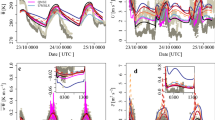Abstract
Nondimensional parameters characteristic of the outer part of the planetary boundary layer have been determined by fitting a simple, Ekman-type theory to a number of averaged, observed velocity distributions, using the Wangara data of Clarke et al. (1971). The theoretical model is based on constant eddy viscosity in the outer layer and a linear variation of the geostrophic wind with height. At the lower boundary of the outer layer, the condition is applied that stress and velocity are parallel. This yields an equation for the cross-isobar angle as a function of drag coefficient, depth coefficient and nondimensional thermal wind.
The data could be sorted into three well-defined, distinct groups, each characterized by a more or less constant value of the depth coefficient. The group with the lowest value of this parameter contains most of the nighttime data, the middle group the remaining nighttime data and most of the daytime ones, and the group with the largest depth, daytime data with cold air advection. The difference between the lowest and highest depth coefficients found here is about a factor of three.
Within each group separately, the theoretically derived cross-isobar angle agrees remarkably well with the observed one, as a function of thermal wind.
Similar content being viewed by others
References
Blackadar, A. K. and Tennekes, H.: 1968, ‘Asymptotic Similarity in Neutral Planetary Boundary Layers’, J. Atmos. Sci. 25, 1015.
Charney, J. G.: 1969, ‘What Determines the Thickness of the Planetary Boundary Layer of a Neutrally Stratified Atmosphere?, Oceanology 9, 111–113 (transl. of Okeanologiia, 961, 1969, American Geophys. Union).
Clarke, R. H.: 1970, ‘Observational Studies in the Atmospheric Boundary Layer’, Quart. J. Roy. Meteorol. Soc. 96, 91–114.
Clarke, R. H., Dyer, A. J., Brook, R. R., Reid, D. G., and Troup, A.J.: 1971, The Wangara Experiment: Boundary Layer Data, Div. Meteorol. Phys. Tech. Paper 19, CSIRO, Australia.
Clauser, F. H.: 1956, ‘The Turbulent Boundary Layer’, Adv. Appl. Mech. 4, 1.
Csanady, G. T.: 1967, ‘On the Resistance Law of a Turbulent Ekman Layer’, J. Atmos. Sci. 24, 467.
Csanady, G. T.: 1972, ‘Geostrophic Drag, Heat and Mass Transfer Coefficients for the Diabatic Ekman Layer’, J. Atmos. Sci. 29, 488–496.
Deardorff, J. W.: 1972, ‘Numerical Investigation of Neutral and Unstable Planetary Boundary Layers’, J. Atmos. Sci. 29, 91–115.
Fortak, H.: 1970, ‘On the Baroclinic Planetary Boundary Layer’, Beitr. Phys. Atm. 43, 35.
Hess, G. D. and Clarke, R. H.: 1973, ‘Comments on ‘Geostrophic Drag’, etc.’, J. Atmos. Sci. 30, 154–155.
Lettau, H. H.: 1950, ‘A Re-Examination of the Leipzig Wind Profile’, Tellus 2, 125.
Sheppard, P. A.: 1954, ‘The Vertical Transfer of Momentum in the General Circulation’, Arch. Geophys. Bioklim. A7, 114.
Taylor, G. I.: 1915, ‘Eddy Motion in the Atmosphere’, Phil. Trans. Roy. Soc. A 215, 1.
Author information
Authors and Affiliations
Rights and permissions
About this article
Cite this article
Venkatesh, S., Csanady, G.T. A baroclinic planetary boundary-layer model, and its application to the Wangara data. Boundary-Layer Meteorol 5, 459–473 (1974). https://doi.org/10.1007/BF00123492
Received:
Issue Date:
DOI: https://doi.org/10.1007/BF00123492




